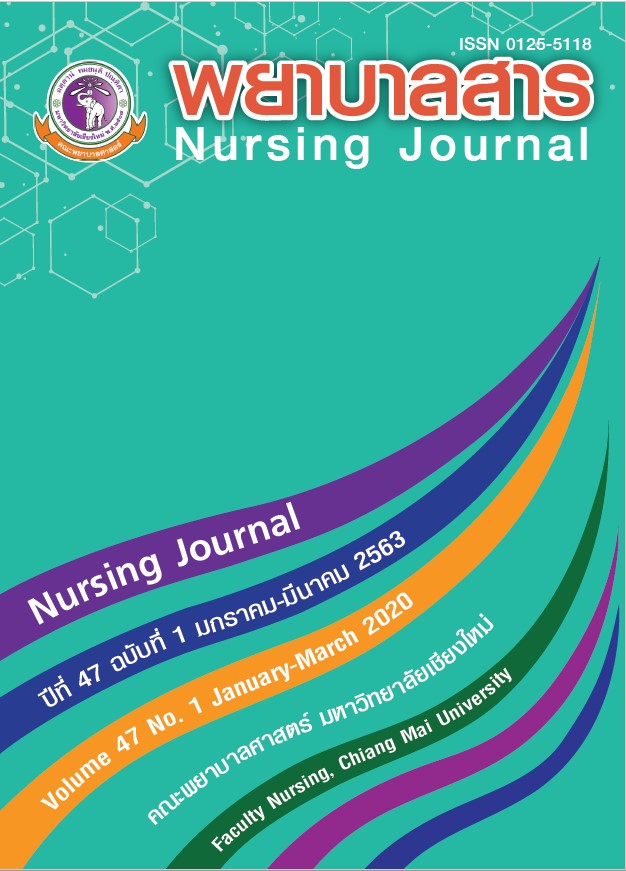Effect of Wearing Plastic Cap on Body Temperature Among Preterm Infants During Umbilical Catheterization
Keywords:
preterm infants, temperature, polyethylene plastic cap, umbilical catheterizationAbstract
Preterm infants are easily heat loss especially during procedure. The purpose of this quasi-experimental study was to study the effect of wearing a plastic cap on body temperature in 20 preterm infants with 28-36 weeks postconceptional age undergoing umbilical catheterization. Ten infants of an experimental group wore a high-density polyethylene plastic cap and receiving routine care and other infants of a control group received routine care only. Infants of both groups were assessed body temperature at behind ear by an infrared thermometer before, every 5 minutes during umbilical catheterization, and after the procedure. The data were recorded in an umbilical catheterization record form skin record form and analyzed using descriptive statistics, independent t-test and Fisher exact probability test. The study revealed that the experimental group had significantly higher body temperatures (p <.001) and significantly lower proportion of the experimental had hypothermia than the control group following umbilical catheterization (p< .05). The findings of this study could be used as a guide for preventing hypothermia during umbilical catheterization in preterm infants. This will reduce the incidence of hypothermia and cold stress.
References
Blackburn, S. T. (2007). Thermoregulation, Maternal, fetal, & neonatal physiology: A clinical perspective. n.p.: Elsevier Health Sciences.
Bredemeyer, S., Reid, S., & Wallace, M. (2005). Thermal management for premature births. Journal of Advanced Nursing, 52 (5), 482-489. doi:10.1111/j.1365-2648.2005.03616
Burns, N., & Grove, S. K. (2005). The Practice of Nursing Research Conduct Critique and Utilization (5 th ed.). Pennsylvania: Elsevier.
Mathew, B., Lakshminrusimha, S., Cominsky, K., Schroder, E., & Carrion, V. (2007). Vinyl bags prevent hypothermia at birth in preterm infants. The Indian Journal of Pediatrics, 74 (3), 249-253.
Nuntnarumit, P. (2015). Measuring and temperature control in neonates. In Pracha Nuntnarumit (Ed.), Application of physiological knowledge to care for newborns (p. 20-49). Bangkok: Holistic.
Rutter, N. (1999). Temperature control and its disorders. In Rennie, J. M., & Roberton, N. R. C.(Eds.), Textbook of Neonatology (pp. 289-294). n.p.: Churchill Livingstone.
Suso, P. (2011). Mechanical properties of plastic tertiary blends high density polyethylene, low density polyethylene and polypropylene (Master’s thesis,Rajamangala University of Technology Thanyaburi).
Swatesutipun, B. (2010). A randomized controlled trial of plastic drape for prevention hypothermia during umbilical catheterization (Master’s thesis, Mahidol University).
Thai Neonatal Society. (2010). Basis newborn care. Bangkok: Pim-luck Printing.
Trevisanuto, D., Doglioni, N., Cavallin, F., Parotto, M., Micaglio, M., & Zanardo, V. (2010). Heat loss prevention in very preterm infants in delivery rooms: A pr ospective, randomized, controlled trial of polyethylene caps. The Journal of Pediatrics, 156(6), 914-917. doi:10.1016/j.jpeds.2009.12.021
Vohra, S., Roberts, R. S., Zhang, B., Janes, M., & Schmidt, B. (2004). Heat Loss Prevention (HeLP)in the delivery room: a randomized controlled trial of polyethy lene occlusive skin wrapping in very preterm infants. The Journal of Pediatrics, 145(6), 750-753. doi:10.1016/j.jpeds.2004.07.036
WHO Newborn CC. (2014). Thermal Protection. Retrieved from www.newbornwhocc.org/
Downloads
Published
How to Cite
Issue
Section
License
บทความที่ได้รับการตีพิมพ์เป็นลิขสิทธิ์ของวารสารพยาบาลสาร
ข้อความที่ปรากฏในบทความแต่ละเรื่องในวารสารวิชาการเล่มนี้เป็นความคิดเห็นส่วนตัวของผู้เขียนแต่ละท่านไม่เกี่ยวข้องกับมหาวิทยาลัยเชียงใหม่ และคณาจารย์ท่านอื่นๆในมหาวิทยาลัยฯ แต่อย่างใด ความรับผิดชอบองค์ประกอบทั้งหมดของบทความแต่ละเรื่องเป็นของผู้เขียนแต่ละท่าน หากมีความผิดพลาดใด ๆ ผู้เขียนแต่ละท่านจะรับผิดชอบบทความของตนเองแต่ผู้เดียว






